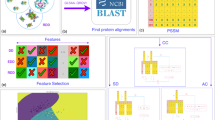Abstract
Protein contact maps are two dimensional representations of protein structures. It is well known that specific patterns occuring within contact maps correspond to configurations of protein secondary structures. This paper addresses the problem of protein fold prediction which is a multi-class problem having unbalanced classes. A simple and computationally inexpensive algortihm called Eight-Neighbour algortihm is proposed to extract novel features from the contact map. It is found that of Support Vector Machine (SVM) which can be effectively extended from a binary to a multi-class classifier does not perform well on this problem. Hence in order to boost the performance, boosting algorithm called SMOTE is applied to rebalance the data set and then a decision tree classifier is used to classify “folds” from the features of contact map. The classification is performed across the four major protein structural classes as well as among the different folds within the classes. The results obtained are promising validating the simple methodology of boosting to obtain improved performance on the fold classification problem using features derived from the contact map alone.
Access this chapter
Tax calculation will be finalised at checkout
Purchases are for personal use only
Preview
Unable to display preview. Download preview PDF.
Similar content being viewed by others
References
Ghanem, A.S., Venkatesh, S., West, G.: Multi-class Pattern Classification in Imbalanced Data. In: ICPR, pp. 2881–2884 (2010)
Day, R., Beck, D.A.C., Armen, R.S., Daggett, V.: A consensus view of fold space: Combining SCOP, CATH, and the Dali domain dictionary. Protein Science 12, 2150–2160 (2003)
Japkowicz, N., Stephen, S.: The class imbalance problem: A systematic study. Intelligent Data Analysis Journal 6(5), 429–450 (2002)
Elkan, C.: Boosting and naive bayesian learning. Technical Report CS97-557, Department of Computer Science and Engneering, University of California,Sam Diego, CA (September 1997)
Freund, Y., Schapire, R.E.: Experiments with a new boosting algorithm. In: Proceedings of the Thirteenth International Conference on Machine Learning, pp. 148–156. Morgan Kaufmann, The Mit Press (1996)
Schapire, R.E., Singer, Y.: Improved boosting algorithms using confidence-rated predictions. Machine Learning 37(3), 297–336 (1999)
Schwenk, H., Bengio, Y.: Boosting neural networks. Neural Computation 12(8), 1869–1887 (2000)
Friedman, J., Hastie, T., Tibshirani, R.: Additive logistic regression: a statistical view of boosting. Annals of Statistics 28(2), 337–374 (2000)
Fan, W., Stolfo, S.J., Zhang, J., Chan, P.K.: Adacost:misclasification cost-sensitive boosting. In: Proceedings of Sixth International Conference on Machine Learning (ICML 1999), Bled, Slovenia, pp. 97–105 (1999)
Ting, K.M.: A comparative study of cost-sensitive boosting algorithms. In: Proceedings of the 17th International Conference on Machine Learning, Stanford University, CA, pp. 983–990 (2000)
Joshi, M.V., Kumar, V., Agarwal, R.C.: Evalating boosting algorithms to classify rare classes: Comparison and improvements. In: Proceeding of the First IEEE International Conference on Data Mining, ICDM 2001 (2001)
Chawla, N.V., Lazarevic, A., Hall, L.O., Bowyer, K.W.: SMOTEBoost: Improving prediction of the minority class in boosting. In: Proceedings of the Seventh European Conference on Principles and Practice of Knowledge Discovery in Databass, Dubrovnik, Croatia, pp. 107–119 (2003)
Guo, H., Viktor, H.L.: Learning from imbalanced data sets with boosting and data generation: The databoost-IM approach. SIGKDD Explorations Special Issue on Learning from Imbalanced Datasets 6(1), 30–39 (2004)
Bhavani, S.D., Suvarnavani, K., Sinha, S.: Mining of protein contact maps for protein fold prediction. In: WIREs Data Mining and Knowledge Discovery, vol. 1, pp. 362–368. John Wiley & Sons (July/August 2011)
Hsu, C., Lin, C.J.: A comparision of methods for multi-class Support Vector Machines. IEEE Transactions on Neural Networks 13, 415–425 (2002)
Barah, P., Sinha, S.: Analysis of protein folds using protein contact networks. Pramana 71(2), 369–378 (2008)
Shi, J.-Y., Zhang, Y.-N.: Fast SCOP Classification of Structural Class and Fold Using Secondary Structure Mining in Distance Matrix. In: Kadirkamanathan, V., Sanguinetti, G., Girolami, M., Niranjan, M., Noirel, J. (eds.) PRIB 2009. LNCS (LNBI), vol. 5780, pp. 344–353. Springer, Heidelberg (2009)
Chmeilnicki, W., Stapor, K.: An efficient multi-class support vector machine classifier for protein fold recognition. In: IWPACBB, pp. 77–84 (2010)
Fraser, R., Glasgow, J.: A Demonstration of Clustering in Protein Contact Maps for Alpha Helix Pairs. In: Beliczynski, B., Dzielinski, A., Iwanowski, M., Ribeiro, B. (eds.) ICANNGA 2007. LNCS, vol. 4431, pp. 758–766. Springer, Heidelberg (2007)
Ding, C.H.Q., Dubchak, I.: Multi-class proteing fold recognition using support vector machines and neural networks. Bioinformatics 17, 349–358 (2001)
Shamim, M.T.A., Anwaruddin, M., Nagarajaram, H.: Support vector machine-based classification of protein folds using the structural properties of amino acid residues and amino acid residue pairs. Bioinformatics 23:24, 3320–3327 (2007)
Zaki, M.J., Nadimpally, V., Bardhan, D., Bystroff, C.: Predicting Protein Folding Pathways. In: Datamining in Bioinformatics. Springer (2004)
Author information
Authors and Affiliations
Corresponding author
Editor information
Editors and Affiliations
Rights and permissions
Copyright information
© 2013 Springer-Verlag Berlin Heidelberg
About this paper
Cite this paper
Suvarna Vani, K., Durga Bhavani, S. (2013). SMOTE Based Protein Fold Prediction Classification. In: Meghanathan, N., Nagamalai, D., Chaki, N. (eds) Advances in Computing and Information Technology. Advances in Intelligent Systems and Computing, vol 177. Springer, Berlin, Heidelberg. https://doi.org/10.1007/978-3-642-31552-7_55
Download citation
DOI: https://doi.org/10.1007/978-3-642-31552-7_55
Publisher Name: Springer, Berlin, Heidelberg
Print ISBN: 978-3-642-31551-0
Online ISBN: 978-3-642-31552-7
eBook Packages: EngineeringEngineering (R0)




